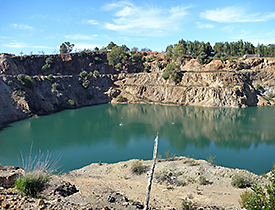Press release, 18th December 2014
Pilot plant for the removal of extreme gas charges from deep waters
Puebla del Guzman (Andalusia) / Magdeburg. Being part of the mining area Herrerias in Andalusia, deep waters of Pit Lake Guadiana show extremely high concentration of dissolved carbon dioxide (CO2). In the case of a spontaneous ebullition, human beings close-by would be jeopardized. To demonstrate the danger and the possible solution, scientists of the Spanish Institute of Geology and Mining, the University of the Basque Country (UPV/EHU, Bilbao) and the Helmholtz Centre for Environmental Research (UFZ) constructed a pilot plant for degassing. A fountain pulls deep water through a pipe to the surface, where the gas can escape from the water. The buoyancy produced by the bubbles provides the energy required for driving the flow.

Pit Lake Guadiana in the former mining area Herrerias in Andalusia, Spain. Photo: Bertram Boehrer/UFZ
„The deep water in the residual lake Guadiana contains an extremely high volume of carbon dioxide (CO
Now the scientists installed a degasing pipe which is the heart of the new pilot plant: Deep water enters a pipe at 61m depth. On the way up, hydrostatic pressure drops and gas bubbles form. The reduced density of the water-gas-mixture allows that
deep water is pushed out of the pipe at the upper end to form a fountain above the water table, where gas is released to the atmosphere. This is an elegant solution, as the system does not require any additional driver, and the controlled release
of CO
Earlier installations in Lake Nyos in Cameroon served as a good example for this approach. In this lake, degassing pipes had been installed, which released the gas load with three fountains. On August 21st 1986, a large volume of gas escaped from the lake suddenly. The gas entered valleys of the surrounding area. 1700 human beings and thousands of animals were killed. The trigger could have been a land slide though this was never really proven. To avoid a repetition of this disaster, the gas load is slowly removed from the lake. One more crater lake called Monoun in Cameroon suffocated 37 human beings close to its shores in a similar eruption. Also in Monoun degasing fountains have been installed.
In Guadiana pit lake we do not see the same danger as in Lake Nyos, due to smaller size and depth. In addition, a density gradient between surface waters and deep waters is keeping the system stable. However, gas concentrations are so high that precaution must be taken. More detailed investigations must be implemented and remediation must be considered, says Dr. Boehrer. For the formation of such extreme gas loads, lakes must be sufficiently deep with incomplete winter recirculation (meromixis) and a strong carbon dioxide source. At the moment, we do not have such a lake in Germany. Tilo Arnhold
Publication
Sánchez-España, J., Boehrer, B., Yusta, I. (2014): Extreme carbon dioxide concentrations in acidic pit lakes provoked by water/rock interaction. Environ. Sci.
Technol. 48 (8), 4273 – 4281. 7
http://dx.doi.org/10.1021/es5006797
Further information
Helmholtz Centre for Environmental Research (UFZ)
Dr. Bertram Boehrer
Phone: ++49-391-810-9441
or via
Susanne Hufe, Tilo Arnhold (UFZ press office)
Phone: ++49-341-235-1630, -1635
Other links
Proyecto de Investigación en Corta Guadiana (in spanish):
http://www.asociacionherrerias.com/es/noticias/a%C3%B1o-2014/291-proye
Impacts of climate change on lakes
http://www.ufz.de/index.php?de=17265
Nyos-See
http://de.wikipedia.org/wiki/Nyos-See
Monoun-See
http://de.wikipedia.org/wiki/Manoun-See
In the Helmholtz Centre for Environmental Research (UFZ), scientists conduct research into the causes and consequences of far-reaching environmental changes. Their areas of study cover water resources, biodiversity, the consequences of climate change and possible adaptation strategies, environmental technologies and biotechnologies, bio-energy, the effects of chemicals in the environment and the way they influence health, modelling and social-scientific issues. Its guiding principle: Our research contributes to the sustainable use of natural resources and helps to provide long-term protection for these vital assets in the face of global change. The UFZ employs more than 1,100 staff at its sites in Leipzig, Halle and Magdeburg. It is funded by the federal government, Saxony and Saxony-Anhalt.
The Helmholtz Association contributes to solving major and urgent issues in society, science and industry through scientific excellence in six research areas: Energy, earth and environment, health, key technologies, structure of matter as well as aviation, aerospace and transportation. The Helmholtz Association is the largest scientific organisation in Germany, with 35,000 employees in 18 research centres and an annual budget of around €3.8 billion. Its work is carried out in the tradition of the great natural scientist Hermann von Helmholtz (1821-1894).
